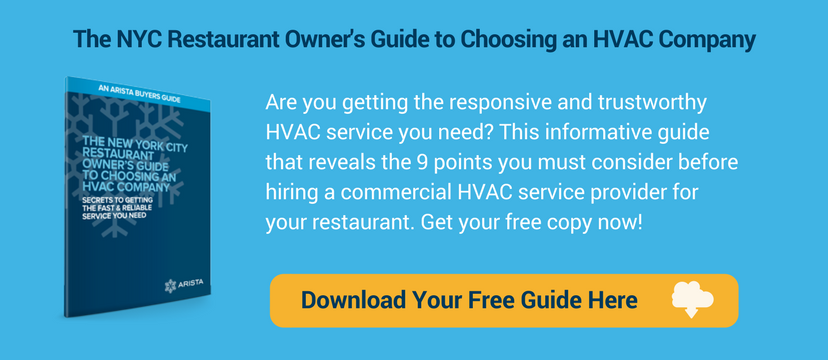Here’s one fact you probably already know: the success of your restaurant is about much more than the food. Restaurant comfort is a big issue for diners, and a prime reason they will choose to frequent your establishment, or not.
Yet getting restaurant comfort right it not as easy as it seems.
Just think about your own experience. It’s probably something like this: your patrons complain about being too hot or too cold, or being bothered by drafts from your AC blowing directly on their food. And making it too loud to carry on a conversation. At the same time, your kitchen is sweltering to the point that people are ready to pass out from the heat. Even worse, you might have kitchen odors migrating to the dining room. That’s not a pleasant experience for your diners, either.
We’ve heard stories like this from the many New York City restaurants we have serviced over the years. Read on to learn why restaurant comfort is a tricky issue. Then we’ll reveal how the right combination of specialized equipment, HVAC system design and maintenance can improve environmental temperature control and solve your problems once and for all.
Why restaurant comfort is so challenging
The simple answer is this: the restaurant environment makes things harder for the traditional HVAC system to provide consistent restaurant comfort. For example:
- Smoke and grease accumulate in the ventilation system and HVAC equipment, causing performance to deteriorate.
- Added heat from kitchen equipment (ranges, grills, ovens and dishwashers) requires extra cooling during peak serving times.
- However, you might need heat in the dining room or in restrooms at the same time. That’s why restaurant HVAC systems must be flexible enough to provide heating and cooling simultaneously.
- High levels of humidity from cooking and running dishwashers make it even harder for HVAC systems to manage restaurant comfort.
What’s needed to fix this situation? It’s a combination of better HVAC equipment, HVAC system design specific for restaurant requirements, and vigilant preventative maintenance.
Specialized equipment & ventilation design improves restaurant comfort
For all the reasons stated above, designing and implementing a restaurant HVAC system requires extensive knowledge of the restaurant environment and the types of specialized equipment that produce optimal restaurant comfort conditions.
Here are a few examples:
VRF systems
VRF systems are a newer HVAC technology that’s popular for providing restaurant comfort. They are designed to solve many of the problems described here. For example, they can provide simultaneous heating and cooling (as well as independently control different zones with different heating and cooling needs). They offer quiet operation, which is also essential for optimal restaurant comfort.
BONUS: they work more efficiently than traditional rooftop or split systems, which means lower energy bills for you.
Learn more: VRF Cooling Systems Provide Customized Comfort for Restaurants
Kitchen ventilation equipment & design
Air quality in your kitchen is critically important, not only for the health and safety of your staff. Air contaminated with smoke, grease and humidity can easily migrate to your dining area, bringing nasty smells and stuffy conditions that impede restaurant comfort for your diners as well.
Improving the air quality in your kitchen involves much more than installing a powerful vent hood. You must choose the right equipment for your kitchen layout and the food you’re cooking. Also, your ventilation design must be properly designed to expel the bad air, replace it with (conditioned) fresh air, and keep air moving the in the right direction.
Learn more: FAQ: Commercial Kitchen Ventilation Regulations & Best Practices
Makeup air systems
Part of proper kitchen ventilation is adding makeup air systems that are specifically designed for restaurants. What a makeup air system does is replace all the air that’s vented from the kitchen by your exhaust systems. Without a makeup air system, you end up with all sorts of unpleasant and even dangerous conditions that hurt restaurant comfort.
Besides the aforementioned odors, you can have a negative air pressure situation that causes high velocity cross drafts, eerie noises, and doors that are hard to open or slam closed without warning. In the worst case, back drafts can cause elevated levels of carbon monoxide and VOCs.
Learn more: 8 Reasons Restaurants Need a Makeup Air Unit for the Kitchen
Environmental temperature control
Environmental temperature control systems improve air quality by properly condition the outside air introduced into your space. These systems are especially valuable in humid environments like a restaurant. The last thing you want is humid air from the outside adding to your restaurant comfort problems inside! These systems remove water vapor from the air to improve restaurant comfort. Since many airborne contaminants (like bacteria and viruses) travel in water vapor, these systems can also help your employees and customers stay healthier.
Don’t neglect regular maintenance
In a restaurant environment, even the most effective new HVAC equipment must be regularly serviced to maintain its level of performance. Again, that’s because of the harsh conditions it works under every day. Grease, soot from smoke, and food particles from cooking all build up inside the equipment.
If you’ve ever taken a look at the inside of a vent hood, you’ll understand what we mean. All that debris can collect on system parts, leading to increased wear and tear as well as decreased performance. That results in declining restaurant comfort.
For example, greasy blower fan blades will slow down fan speed, reducing the airflow in your system. Also, the debris that collects on your AC coils impedes the transfer of heat, making it work harder and run longer trying to bring the space to set temperature. And driving up your utility bills in the process.
If you’re not sure the HVAC company you’re dealing with has the expertise needed to fix your restaurant comfort problems, here’s a reference that can help you find someone else who can: The NYC Restaurant Owner’s Guide to Choosing an HVAC Company.


